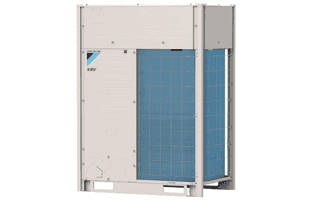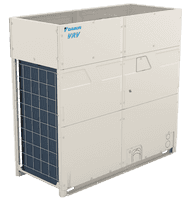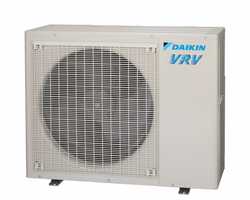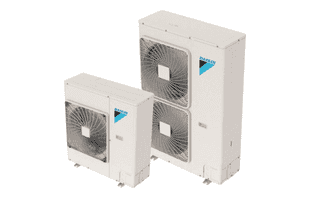Daikin VRV
Other Daikin VRV Condensing Units
Standard Heating (-13°F) High Ambient Cooling (122°F)
6 to 38 Tons
VRV-IV-X Heat Recovery
***Warning: Transitioning to R-32***
Model: REYQ_X
Refrigerant: R-410A

6 to 32 Tons
VRV-IV-X Heat Pump (575V Only)
***Warning: Transitioning to R-32***
Model: RXYQ_X
Refrigerant: R-410A

6-40 Tons
VRV Emerion Heat Recovery
***Warning: Transitioning to R-32***
Model: REYQ_A
Refrigerant: R-410A

6 to 40 Tons
VRV Emerion Heat Pump
***Warning: Transitioning to R-32***
Model: RXYQ_A
Refrigerant: R-410A

Cold Climate Heating (-22°F) High Ambient Cooling (122°F)
- Why do I only see the single phase R-32 units?
Currently, only the single phase VRV-S R-32 units have information publicly available. Contact your local Daikin representatives for preliminary information and selections for other R-32 VRV systems. You may use the "R-32" and "R-410A" tabs at the top of the page to toggle between the R-32 and the R-410A lineups. Note that many R-410A systems are approaching or already beyond their last order dates.
- Where can I learn more about R-32 and the refrigerant transition?
Please visit the DXS Refrigerant Transition Resource Center for more information: https://info.dxseng.com/dxs-refrigerant-transition-resource-center
- How do I choose between standard heating and cold climate heating?
Both standard and cold climate systems are used for low ambient heating, even in cold regions. Cold climate units extend the officially tested operating range from -13F to -22F. Cold climate units also output more heating capacity at low ambient, delivering 100% capacity at 0F (vs 60-70% for standard units), 85% at -13F and 60% at -22F. Your heating design temperature is definitely an important decision factor for choosing between the two. Areas that may see multiple hours below -13F should either consider using cold climate systems, or using supplemental heat. However, your heat load profile and the ratio between your peak heat loss and your peak cooling gain are usually the primary decision factors. Many new buildings, even in cold regions, have a much higher peak cooling load than they have heat loss, therefore standard units size for the large peak cooling load tend to deliver enough capacity in heating to cover the low heat loss. Retrofit buildings in cold regions tend to take more advantage of cold climate units, as well as extreme cold regions with design temperatures well below 0F.
- What is 'water-cooled' VRV?
Water-cooled VRV systems are very similar to air-cooled VRV systems, in that they use similar technology, similar compressors, and the same lineup of indoor units and controls. Water-cooled systems can also be either heat pump or heat recovery. The water-cooled condensing units reject and inject heat to and from a condenser water loop, instead of rejecting and injecting from ambient air. These condenser water loops need to be maintained within certain temperature ranges, accomplished by either a cooling tower / dry cooler combined with boilers, or via a geothermal loop. These systems are popular in extreme cold climate regions, since the system is no longer extracting heat from outdoor ambient in the Winter. These systems are also used in high rise applications, with condensing units mounted on each floor. Finally, these systems are also used in large properties with existing hydronic infrastructure.
- What is VRV-S Single Phase?
Also known as mini-VRV, or "VRV-Small", or "VRV-Suitcase", these are small heat pump only (no heat recovery) VRV systems that range from 2 to 5 Tons. These condensing units have access to the full VRV indoor unit and controls line-up. These systems can be used residentially, and are also often used in small light commercial applications.
- What are single, dual and triple modules?
VRV systems are modular. Depending on the outdoor unit type, condensing unit modules can be combined together on site by connecting refrigerant piping to two or even three modules. The term single module refers to one machine, with a dedicated electrical connection. Single modules can be used as stand alone systems, or they can be combined into larger dual or triple module systems. When combining modules, they are normally mounted near each other, and manufacturer specific refrigerant connection pipe kits are provided to properly combine refrigerant piping. Dual and triple module systems provide a long list of advantages, such as reducing the amount of refrigerant piping going into your building, offering some level of redundancy in case of failure, and allowing full continuous heating during defrost (for Daikin). Draw backs of multi module systems are higher refrigerant charges, which can be an issue for ASHRAE 15 limits, and usually a great building area being affected should there be equipment failures.
- How do I size my VRV outdoor unit?
VRV outdoor units should be sized to meet both the cooling load and the heating load of the zones that its indoor units are serving. Most regions are driven by the cooling load, whereas cold climate regions can be driven by the heating load. The 'block loads' should be looked at, refering to the maximum simultaneous load that the outdoor unit will need to deliver, taking diversity into account. Finally, it is important to compare these loads with the outdoor unit capacities at design temperatures, especially in heating. For example, if a building in a cold climate region has a block cooling load of 10 Tons, and a block heating of also 10 Tons, then a 10 Ton standard VRV outdoor unit would actually be undersized, since the heating capacity of a 10 Ton standard unit at lower ambient is less than 10 Tons. Therefore, the right selection would either be a 12 Ton or a 14 Ton standard unit, or a 10 Ton Cold Climate Aurora condensing unit.


